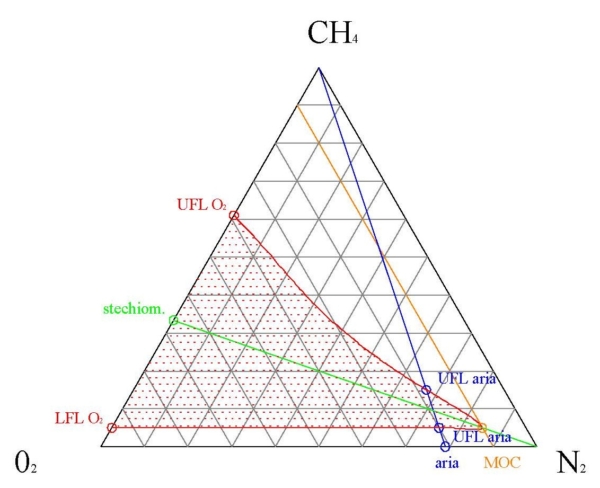The significant environmental impacts that can arise from the management of landfills can be divided into small-scale and large-scale impacts.
The effects of the first type are felt in the vicinity of the landfill (up to a few kilometres away) and are those that create the greatest problems of acceptance by the surrounding population due to the emission of strong-smelling compounds.
The large-scale impacts, on the other hand, are mainly linked to the decisive contribution to the greenhouse effect due to the release of CO2 and in particular CH4 into the atmosphere. Over a period of 100 years, methane is characterized by a Global Warming Potential (GWP) 28 times greater than carbon dioxide, as reported in the fifth and last assessment report from the IPPC issued in 2014 and called AR5.
Leaving an in-depth analysis of the greenhouse effect for a specific discussion, below we will give a brief description of these important impacts represented by biogas:
- THE OLFACTORY IMPACT,
- THE RISKS OF FIRE AND EXPLOSION,
- THE RISKS OF ASPHYXIATION,
- THE RISKS OF INTOXICATION,
- PHYTOTOXICITY,
- THE SYNERGY OF ALL THESE EFFECTS.
1 – OLFACTORY IMPACT:
With reference to the environmental component of air, the initial discomfort experienced near a landfill plant is determined by the emissions of odours, due to the presence of certain odorous micro-components in the biogas such as esters, sulphur compounds (such as hydrogen sulphide) , alkylbenzenes, limonene, mercaptans, putrescine, thiophenols, thioalcohols, thioacids, polyamines and other hydrocarbons that are emitted into the atmosphere.
The flow of biogas that is not collected diffuses the micro-components that are perceptible in olfactory terms into the atmosphere and the meteorological agents move them around the local area. When this happens, bad smells cause undeniable, persistent annoyance for the population residing in the vicinity, becoming an element of conflict both in the case of existing plants and in the choice of the location for future plants.
Given the evidence of the difficulties connected to the subjectivity of olfactory perception and the ways of determining odours in the environment and remembering that the definition of regulatory limits on emissions constitutes a problem that is not easy to solve, it should be noted that in recent years, the regulations have taken some steps forward towards instruments of organicity.
In Italy, from 19 December 2017, with the introduction of Article 272-bis to the Consolidated Environmental Text, it has been official that odour-generating emissions represent a form of atmospheric emission and that therefore provisions, decisions or measures (technical and/or managerial in nature) can be taken to prevent and limit them, introducing a specific possibility for regional legislation and for the Competent Authorities, in the authorization stage, to provide for prevention and limitation measures specifically defined for odour-generating emissions. In this way, with the intervention implemented by Italian Legislative Decree 183/2017, the national legislator rationalizes and formalizes a series of powers already provided for by regional laws, opening up – with paragraph 2 – to the unification of the various regional regulations.
From a technical and management point of view, the presence of an efficient collection system in the landfill minimizes the dispersion of biogas into the atmosphere, eliminating the olfactory impact upstream due to odorous micro-components.
2 – RISKS OF FIRE AND EXPLOSION:
A considerable number of accidents originating from the presence of non-collected biogas have occurred throughout history, and the consequences have been substantial both from the point of view of material and environmental damage and as regards the health and safety of the people involved.
Technical literature highlights the flammability and explosiveness characteristics of biogas.
So-called biogas flammability is mainly due to the presence of methane (CH4) and molecular hydrogen (H2), highly flammable gases capable of forming explosive mixtures in air within certain concentration ranges.
The flammability/explosiveness ranges of methane and hydrogen are respectively:
- for methane CH4 in the air:
- 5% vol (LFL Lower Flammability Limit)
- 15% vol (UFL Upper Flammability Limit)
- 5% vol (LEL Lower Explosive Limit)
- 15% vol (UELUpper Explosive Limit)
- for molecular hydrogen H2 in the air:
- 4% vol (LFL Lower Flammability Limit)
- 74% vol (UFL Upper Flammability Limit)
- 4% vol (LEL Lower Explosive Limit)
- 74% vol (UELUpper Explosive Limit)
and the reaction between the fuel (CH4, H2) and the combusting agent (O2) is not spontaneous but occurs due to an external trigger (such as a spark or heat source).

It should, however, be noted that the flammability range of biogas is different from that of methane due to the presence of inert gases (mainly carbon dioxide and nitrogen) which modify the flammability ratio described for methane alone;
furthermore, it should be noted that the flammability diagrams vary according to the biogas taken into consideration, as each biogas is characterized by specific macro- and micro-components and by specific concentrations of these macro- and micro-components.
The risk of explosion in landfills is latent the more the mixture of methane and saturated air is kept within confined spaces (e.g. electrical panels, underground wells, septic tanks for sewage discharge etc.) where the migrating biogas has accumulated.
The potential explosiveness of biogas may also lead to instability of the landfill body and cause landslides, resulting in damage to people and things.
For this reason, it is necessary to implement all the techniques to reduce the risk associated with fire and explosion. An efficient collection system prevents biogas overpressures inside the landfill and prevents free dispersions of biogas into the atmosphere, significantly reducing this risk.
3 – RISKS OF ASPHYXIATION:
The risk of asphyxiation can also be correlated to the migration of volumes of biogas into the landfill. Assuming that the density of the biogas is higher than that of the air, it is possible that volumes of these gases can saturate depressed or confined spaces.
Biogas can, in fact, cause asphyxiation in confined spaces (such as wells, tunnels or underground chambers of the landfill) with an oxygen content of less than 18% by volume.
With an efficient collection system, biogas overpressures inside the landfill can be prevented, stopping these risk situations from occurring.
4 – RISKS OF INTOXICATION:
The biogas content of some gases present in traces can represent a risk to the health of the human organism due to their specific characteristics and properties, such as carbon monoxide, hydrogen sulphide and chlorinated hydrocarbons, which are toxic compounds even at low concentrations.
Some elements of biogas, or their derivatives, also have corrosive potential; carbon dioxide, for example, is soluble in water and can generate an ionic solution of carbonic acid, capable of corroding a wide range of materials.
And since the composition of the biogas can be very variable, please refer to the compounds of the biogas concerned themselves and, consequently, to the specific technical literature that deals with the categories of toxicity of each one (Italian Legislative Decree 81/2008 as amended – Annex XXXVIII – Occupational exposure limit values).
Here, we will limit ourselves to giving the TWA (time-weighted average) and STEL (short-term exposure limit) values of four of the gases that make up the biogas:
| TWA | STEL | |
| Carbon dioxide CO2 | 5000 | – |
| Hydrogen Sulphide H2S | 10 | 15 |
| Carbon monoxide CO | 35 | 50 |
| Ammonia NH4 | 20 | 50 |
specifying that under normal conditions, it is difficult for biogas concentrations with significant toxicity levels to be generated in landfills. It is nevertheless considered necessary to use adequate personal protective equipment (PPE) in all cases of activities that may be subject to biogas emission concentrations (e.g. collection well drilling, wellhead maintenance etc.).
Another less negligible aspect in terms of risk of intoxication is linked to the presence of fires in landfills. In these cases, combustion of waste consisting for example of plastics containing chlorine can take place at low temperatures, during which dioxins and other harmful substances can be released.
5 – PHYTOTOXICITY:
With reference, on the other hand, to the soil environmental component, vegetation in the vicinity of the landfill site may be harmed, mainly due to the lack of oxygen at the roots of the plants where the gradual replacement of biogas with oxygen may lead to their death by asphyxiation. Another factor that may contribute to oxygen deficiency is the presence of methane in the biogas. Although it has no direct effect on plant growth, it is subject to bacterial oxidation by methanotrophic bacteria that require oxygen, thus stealing it from the plants.
Not all types of plant react in the same way to the action of biogas, of course, but evident damage is found where there is considerable migration of gas towards the cover of the landfill featuring vegetation.
So as not to neglect the extent of the problem, it should be emphasized that this risk does not only concern the vegetation above the landfill cover, but may also affect crops or vegetation adjacent to the landfill in the case of biogas migration into the ground. Over the years, in fact, there have been several occasions on which damage to vegetation has brought to light the problem of biogas emissions from the landfill.
And even in this circumstance, an efficient collection system can prevent these risk situations from occurring.
6 – SYNERGY OF EFFECTS:
It is possible that all the risks highlighted so far occur simultaneously, and for this reason precautions, monitoring actions and the application of targeted risk reduction techniques are required. One of these actions of fundamental importance is ensuring efficient collection, with the aim of preventing the dispersion of biogas, keeping the pressure inside the landfill within values slightly lower than atmospheric ones.

